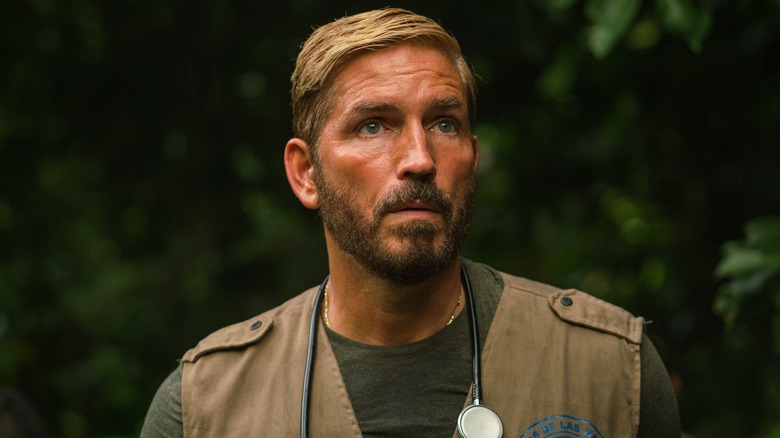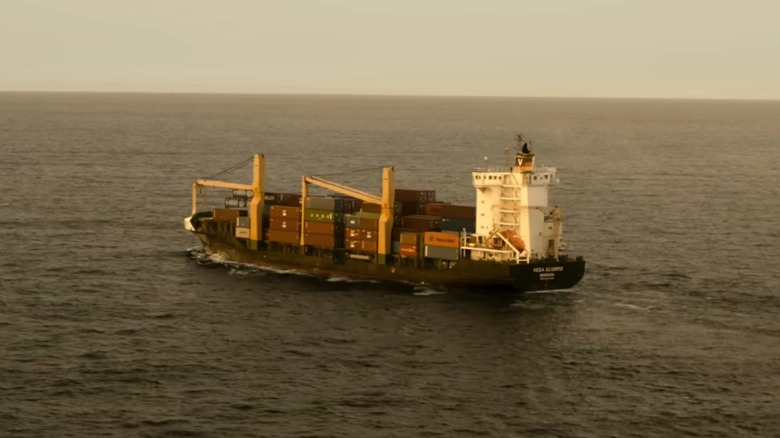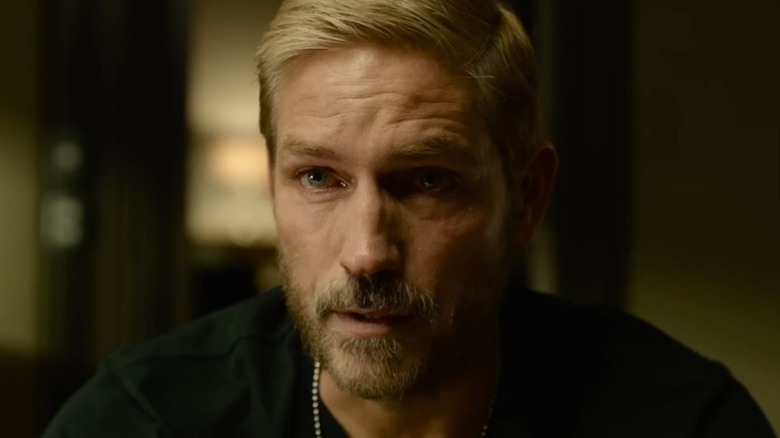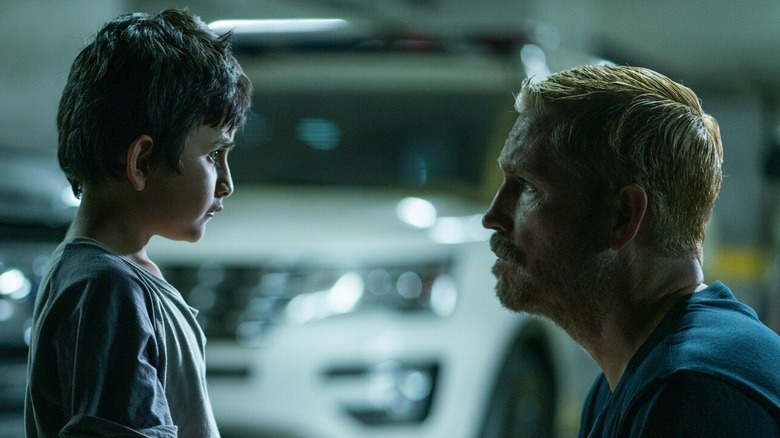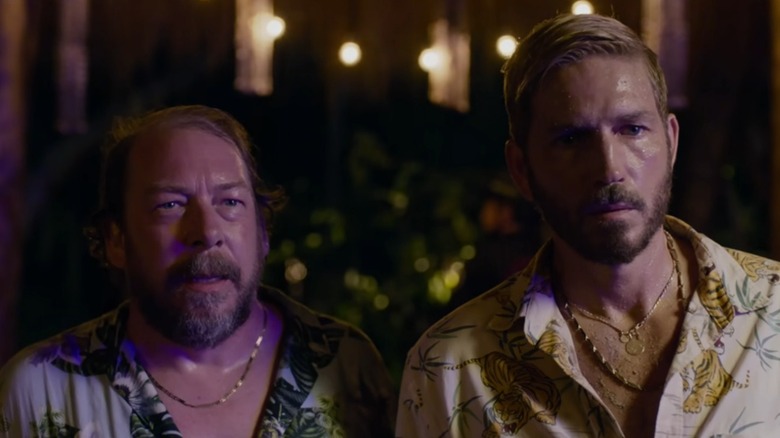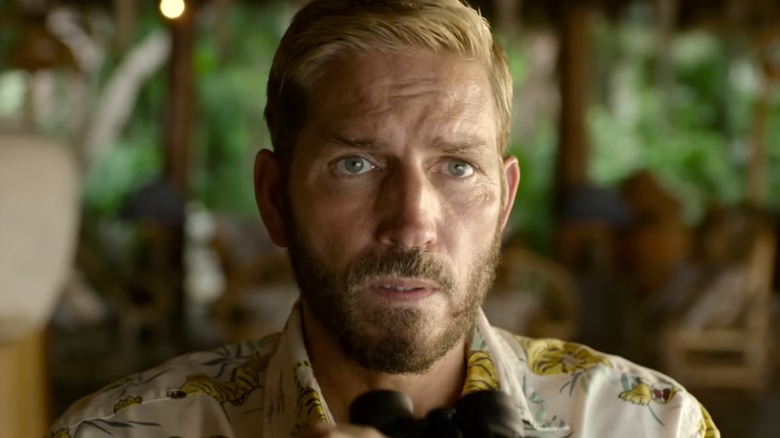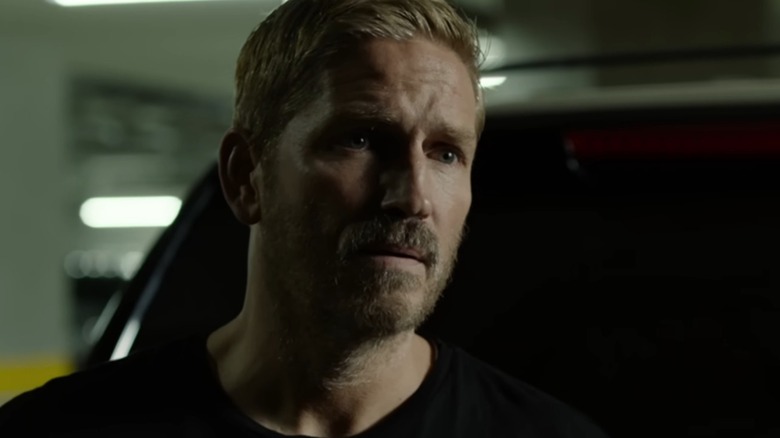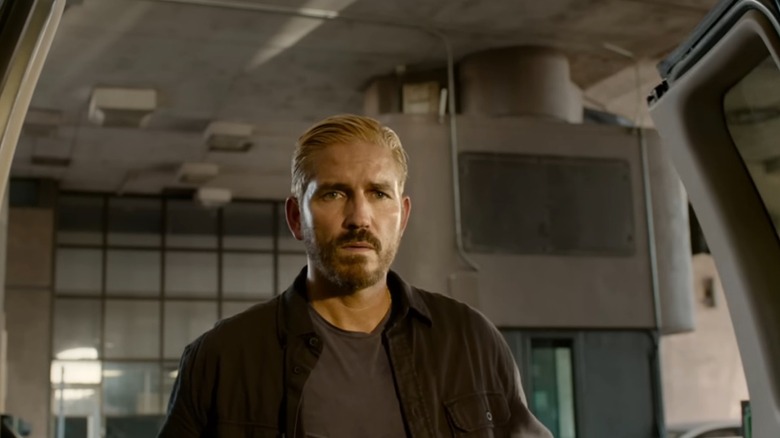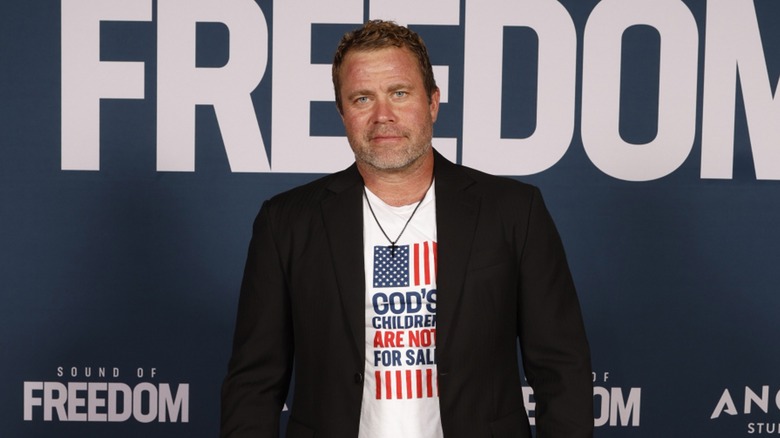Everything Sound Of Freedom Gets Wrong About The True Story
This article contains discussions of child abuse.
For anyone not familiar with Tim Ballard and his nonprofit organization Operation Underground Railroad, "Sound of Freedom" might seem to have come from nowhere. The buzz around the film has primarily been about its surprising box office performance — on a budget of around $15 million, "Sound of Freedom" outperformed many big-budget films — and its star's shocking claims. Jim Caviezel, who portrays Ballard in the movie, has notably attended QAnon events and repeatedly made outrageous claims that traffickers harvest children's blood for a special chemical that keeps them young.
Aside from its connection to Caviezel, the movie doesn't have anything to do with QAnon or other conspiracy theories. Instead, it's based on Ballard's real life and tells the story of how he left his job at the Department of Homeland Security to form OUR, which works to save victims of child trafficking. Ballard spent years working with and promoting OUR, though in the lead-up to the film, he left his position at the organization.
If "Sound of Freedom" is supposed to be a true story, then it's one of the least accurate biopics ever made. The movie is really more of an action thriller, and as such it frequently bends the truth and often outright invents plot beats and characters. Separating fact from fiction is never easy, but we've done the deep dive for you. Here's everything "Sound of Freedom" gets wrong about the true story.
It misrepresents how trafficking usually happens
It's no secret that "Sound of Freedom" presents a sensationalized version of human trafficking. The movie needs to set up a plot that will hit all the usual action movie beats, so its traffickers are shadowy villains who swoop in and snatch children away from their families. The movie's opening actually includes a montage of security camera footage showing literal shadowy figures grabbing children off the street.
The sad truth is that most victims of trafficking aren't attacked by total strangers and whisked away into the night. Instead, they are usually manipulated over a period of time by someone they know, whether that be a family member, friend, or partner. The most prevalent kind of trafficking is neither dramatic nor cinematic.
It makes sense that "Sound of Freedom" would emphasize the significantly rarer kind of trafficking. However, it's really important for people to understand that the movie's presentation of trafficking isn't accurate. It's less important to be worried about strangers on the streets than it is to be watching for subtle signs of emotional and physical abuse from close friends and loved ones. There's no denying that human trafficking is a serious worldwide problem, but people need to have a proper understanding of the problem in order to address it.
It misrepresents the victims of trafficking
"Sound of Freedom" doesn't just misconstrue how human trafficking typically happens. It also seriously misrepresents who the victims of trafficking tend to be. Miguel (Lucás Ávila) and Rocío (Cristal Aparicio), the siblings at the heart of the film, are very young children sold into the sex trade. Almost all the victims depicted in the film are children, but that's not exactly true to life. In reality, victims of trafficking are just as, if not more, likely to be sold as laborers, which is why people of all genders and ages can be trafficked. Trafficking victims also don't exclusively come from outside the United States.
When it comes to child trafficking specifically, most victims still don't match the movie's representation. Most children who are trafficked are adolescents or teenagers, with the majority falling between the ages of 15 and 17. They often come from underrepresented communities, and many of them are LGBTQ and find themselves taken in by traffickers after being kicked out of their homes. A minority of trafficking victims are young children, and the sad truth is that of those victims, their parents are often complicit in their trafficking.
Just like the movie's representation of how trafficking works, its depiction of victims makes sense in a cinematic context. Audiences are going to have a deeply emotional response to seeing young children as trafficking victims in the film. But once again, understanding the truth about trafficking is a prerequisite to addressing the problem in the real world.
If you or someone you know may be the victim of child abuse, please contact the Childhelp National Child Abuse Hotline at 1-800-4-A-Child (1-800-422-4453) or contact their live chat services.
Ballard didn't really do so much solo work
Before Tim Ballard starts adventuring through the jungle to save child trafficking victims, he works as a Department of Homeland Security agent. In that role, Ballard's job is less about finding children and more about catching perpetrators. Early in the film, Ballard has something of a crisis of faith and starts taking a new initiative in his work.
Ballard pretends to be a pedophile to get close to Ernst Oshinsky, a man he just arrested. Oshinsky eventually leads Ballard to another man named Earl Buchanan, who purchased Miguel after the boy was stolen from his family at the beginning of the movie. After separating Miguel from Buchanan, Ballard takes the young boy out for burgers, and there he becomes committed to finding Miguel's sister Rocío. The real Buchanan, however, was not a child trafficker and was instead arrested for possessing and transporting child pornography, with child molestation charges levied after by state officials.
Obviously as the hero of what's ostensibly an action movie, Ballard needs plenty of opportunities to take things into his own hands. In real life it's doubtful he did so much solo work with perpetrators while working for Homeland Security, but his dinner trip with Miguel definitely didn't happen. "A lone agent is never going to be alone like that with a victim," Erin Albright, who worked as a fellow for the Department of Justice's anti-trafficking task force, told Rolling Stone. Albright said the misrepresentation is especially galling because "What [audiences] are learning [from the film] is so divorced from reality that it does sling back to create harm."
Miguel's story is largely fabricated
Miguel is arguably the most important character in "Sound of Freedom." Tim Ballard's conflicted thoughts about his job with the DHS lead him to meeting Miguel, but it was really the young boy's story that drove Ballard to become a vigilante trafficking hunter. In the film, Ballard first meets Miguel while arresting Earl Buchanan, and the young boy gives Ballard a necklace from his sister Rocío and begs Ballard to try and find his sister.
Naturally "Sound of Freedom" needed to change some details about Ballard's true story in order to turn it into a movie. Most viewers will probably be shocked to learn, however, that almost every detail of Miguel's story was completely fabricated for the movie. Everything from Miguel's "kidnapping" to his connection with Ballard was entirely different in real life.
Independent watchdog American Crime Journal investigated Buchanan's arrest and found the details to be wildly different from what "Sound of Freedom" presents. Buchanan was crossing from Mexico into the United States when he was captured, but Ballard wasn't present for the arrest. Buchanan wasn't any kind of suspect when he made the border crossing, but he didn't have Miguel's birth certificate with him, so Border Patrol agents searched his vehicle. They found a videotape of Buchanan sexually abusing Miguel and arrested him. Ballard only got involved because he was sent by DHS to collect the tape. The biggest change that "Sound of Freedom" made to the true story is adding Miguel's sister into the plot. In real life, she was back at home with Miguel's family when Buchanan was arrested and never ended up being trafficked herself. The same watchdog, American Crime Journal, exposed inconsistencies within Ballard's story of getting a necklace from a trafficked child.
If you or someone you know may be the victim of child abuse, please contact the Childhelp National Child Abuse Hotline at 1-800-4-A-Child (1-800-422-4453) or contact their live chat services.
Vampiro's backstory is made up
Not every inaccuracy in "Sound of Freedom" has needed to be uncovered by journalists and human trafficking experts. There are some details in the movie that the filmmakers readily admit were invented for the story. For example, though Vampiro (Bill Camp) is based on a real person, the most important parts of his backstory in the film are fictional.
In the movie, Vampiro becomes an important partner in Ballard's mission to save child trafficking victims. Vampiro formerly spent time in jail, and, even more importantly, he once hired a prostitute, only to discover later that she was 14 years old. Vampiro was disgusted with himself and decided to start working on behalf of trafficking victims.
Angel Studios, the distributor behind "Sound of Freedom," published a blog post comparing some of the film's details to the true story. According to the post, Vampiro never spent any time in jail, and he never slept with an underage girl. His entire motivation in the movie was made up, as was his real involvement with Ballard. The post explains that Vampiro didn't actually work with Ballard on the mission depicted in the film, though he did apparently work with Ballard and Operation Underground Railroad on a different raid in Colombia.
Ballard didn't really go into the jungle
The ending of "Sound of Freedom" gives us the film's most noticeable embellishment on the true story. In his attempt to find Miguel's sister, Rocío, Ballard leads an operation in Colombia that recovers over 50 child trafficking victims. The filmmakers claim that the real-life version of the mission ended up saving 123 trafficking victims, though not all of them were children. After the operation, the rest of the movie leaves reality behind.
In the film, Tim doesn't find Rocío amongst the other children that he saves. He's still unwilling to give up on his search for Miguel's sister. He and Vampiro discover that the girl was sold to a group that lives deep in an unmapped jungle. Almost any visitors to the area will be killed upon arrival, so Ballard and Vampiro disguise themselves as doctors to successfully sneak into the camp.
As far as action movie climaxes go, Ballard charge into the jungle is pretty compelling. It's also entirely made up. In real life, Ballard never made a solo plunge into a dangerous jungle to save a child trafficking victim. And the excursion Ballard was a part of that involved disguising as a U.N. doctor did not lead to any rescued children. We've already seen that the movie's representation of Ballard's story, and trafficking as whole, is much larger than life, so it shouldn't come as much of a surprise that the film's dramatic conclusion isn't part of the true story.
Ballard hasn't really killed anyone
"Sound of Freedom" puts plenty of effort into transforming Tim Ballard into an action hero. He's depicted as a man willing to do anything to save children, and he's seemingly the only person ready to face the reality of how brutal that work can be. During Ballard's jungle excursion at the end of the movie, he shoots a man before finally saving Rocío.
In the movie, Ballard's killing comes across as completely justified and even heroic. In real life, an extrajudicial killing like that would come with some massive moral and legal implications. That's probably why, in its blog post addressing the film's relation to reality, Angel Studios noted, "Tim Ballard is committed to rescuing children ... and operates within the boundaries of the law, collaborating with local authorities and governments to combat child trafficking."
The real Ballard has never killed anyone, and if he had, it would have been illegal. Having Ballard kill someone in the film's climax might make sense for an action movie, but it's another example of how "Sound of Freedom" shows a distorted version of human trafficking. The problem with this presentation is that it might convince some viewers that the solution to trafficking is a rugged individual willing to do anything. Real-life experts agree that actual solutions to trafficking look more like government programs put in place to support runaway children, poor families, parents struggling with addictions, and migrants who might be taken advantage of by bad actors.
The movie's statistics are somewhat disingenuous
The movie caps off its story by making some pretty bold claims about human trafficking. A title card at the end of the film says that, "Human trafficking is a $150 billion a year industry." Another makes the claim that, "There are more humans trapped today in slavery than at any point in human history, including when slavery was legal."
Human trafficking is a serious and horrifying problem that needs to be addressed, but neither of those claims gives audiences the best impression of reality. Trafficking is estimated to generate roughly $150 billion in profits each year, but that number has very little to do with the context of the movie because the majority of trafficking victims aren't young children and aren't sold into the sex trade. Most of that money comes from forced labor, which is disgusting in its own way.
"Sound of Freedom" isn't the only source to claim that more humans are slaves today than at any other point in history — The Guardian stated the same fact in a 2019 article — but regardless of who's making the statement, there's little evidence to support the claim and a wide range of what can be considered "slavery." "While we can't be sure exactly where this claim came from," writes Brayden Gerrard, "it doesn't seem to have any credible analysis behind it that supports the assertion." Historical records of slavery do surprisingly little to inform us how many slaves there once were. At the same time, organizations disagree on what slavery means in a modern context, and no matter the definition, getting exact numbers is nearly impossible.
Ballard's history is much more complicated
"Sound of Freedom" positions Tim Ballard as an unabashed hero working to save children, and it concludes that he and his organization, Operation Underground Railroad, have been undeniably effective in their work. The real story is much more complicated.
In 2020 Vice published an investigation of Ballard and OUR. That reporting found the organization has a long history of obfuscating the work that it does and has occasionally made claims that are outright false. OUR releases very few concrete details about the work that it does or how it spends the millions it receives in donations each year. The organization claims that it needs to keep that information confidential to continue being effective, but some of its most sensational rescue stories have turned out to be false.
Ballard has repeatedly told stories about OUR rescuing a child trafficking victim called Liliana. According to Ballard, Liliana was kidnapped as a young teenager and sold into the sex trade. He's used her story to argue that there needs to be a border wall between the U.S. and Mexico. However, when Vice investigated, it found that Liliana had actually known her trafficker. As is common in these cases, he was her boyfriend at the time. Even more shocking, OUR didn't rescue Liliana — she rescued herself by escaping her trafficker when she was 17 years old. Just like "Sound of Freedom," Ballard may be well-intentioned, but it's worthwhile to not take every claim at face value.
If you or someone you know may be the victim of child abuse, please contact the Childhelp National Child Abuse Hotline at 1-800-4-A-Child (1-800-422-4453) or contact their live chat services.
